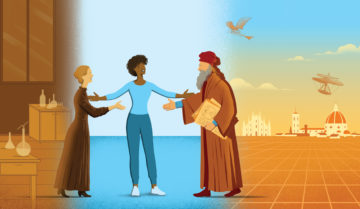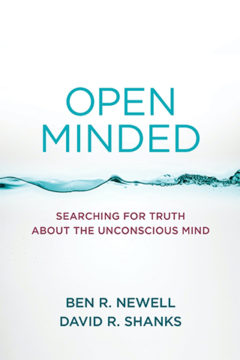Category: Recommended Reading
What Is Empathy Overload?
Emilie Lucchesi in Discover:
 In 1978, Kathy Kleiner was asleep in her bed at the Chi Omega sorority house at Florida State University when serial killer Ted Bundy entered through an unlocked door. After attacking two of her sorority sisters, Bundy found Kathy’s door also unlocked. Kathy survived the attack and is one of only a few Bundy survivors. When we began writing her memoir, A Light in the Dark: Surviving More Than Ted Bundy, she said she wanted to weave in as many stories about the other victims as possible. For about two years, I researched the more than 30 women and girls Bundy killed. By the time I started compiling their biographies for an appendix, I often felt stressed, saddened and a bit on edge. There were certain victims who I thought about daily. Later, I learned I had empathy overload, an experience that social scientists are finding can happen to people in both their professional and personal lives.
In 1978, Kathy Kleiner was asleep in her bed at the Chi Omega sorority house at Florida State University when serial killer Ted Bundy entered through an unlocked door. After attacking two of her sorority sisters, Bundy found Kathy’s door also unlocked. Kathy survived the attack and is one of only a few Bundy survivors. When we began writing her memoir, A Light in the Dark: Surviving More Than Ted Bundy, she said she wanted to weave in as many stories about the other victims as possible. For about two years, I researched the more than 30 women and girls Bundy killed. By the time I started compiling their biographies for an appendix, I often felt stressed, saddened and a bit on edge. There were certain victims who I thought about daily. Later, I learned I had empathy overload, an experience that social scientists are finding can happen to people in both their professional and personal lives.
What is Empathy?
Empathy is typically considered how a person understands and relates to others. Some scientists have suggested empathy evolved as a neurobiological process so that a person would be compelled to create and keep social bonds. These social bonds would motivate the person to get along with other group members and strive for their children’s survival. A person can experience empathy overload, a type of compassion fatigue, which occurs when they are negatively impacted after providing emotional support to others. Compassion fatigue is a relatively new concept in trauma studies. In the 1970s and 1980s, researchers began to more widely recognize that trauma impacted both the mind and the body.
More here.
NextGen Voices: Historic introductions
From Science:
 We asked young scientists this question: If you could introduce any two scientists, regardless of where and when they lived, whom would you choose, and how would their collaboration change the course of history? Read a selection of the responses here. Follow NextGen Voices on social media with hashtag #NextGenSci.
We asked young scientists this question: If you could introduce any two scientists, regardless of where and when they lived, whom would you choose, and how would their collaboration change the course of history? Read a selection of the responses here. Follow NextGen Voices on social media with hashtag #NextGenSci.Improved medicine
Jon Fosse: An Appreciation
Randy Boyagoda at the New York Times:

Bookish flexing aside, I have for years been an evangelist for Fosse, who won the Nobel Prize in Literature on Thursday. And “evangelizing” is an apt word, given the vibrant, mirror-dark religious feeling of his books. Fosse converted to Catholicism in 2012, when he was already a well-established playwright and fiction writer in his native Norway, which celebrates Fosse with a biannual festival dedicated to his work. (The most recent took place this past summer, over 12 days.) His international stature and popularity in a generally secular country is a strong indicator that Fosse’s books aren’t just for the faithful: Indeed, many religiously minded readers of the Chesterton, Lewis and Tolkien club may be put off by Fosse’s formal and stylistic demands, and also by his obscure, at times even willfully inchoate writing about human and divine life.
The Nobel announcement comes only a few weeks before his latest novel, “A Shining,” will be published in English (beautifully and brilliantly translated, as was “Septology,” by Damion Searls), and it affords an excellent occasion to make a stronger case for why reading Fosse is a singular and transporting experience.
more here.
Ed Ruscha’s Calmly Collapsing America
Jackson Arn at The New Yorker:
 In a past life, he was an arsonist. A bold accusation, I realize, but nobody makes that many paintings, drawings, and photographs of fire without some buried lust for the real deal. By the time I left “Ed Ruscha / Now Then,” an XXL retrospective at moma comprising some two hundred works produced between the Eisenhower years and the present, I had lost count of the burning things, which are as lowbrow as a diner and as la-di-da as the Los Angeles County Museum of Art. The title of Ruscha’s 1964 photo series, “Various Small Fires and Milk,” could have been, minus the milk, a reasonable title for the exhibition itself, if he hadn’t painted various large ones, too.
In a past life, he was an arsonist. A bold accusation, I realize, but nobody makes that many paintings, drawings, and photographs of fire without some buried lust for the real deal. By the time I left “Ed Ruscha / Now Then,” an XXL retrospective at moma comprising some two hundred works produced between the Eisenhower years and the present, I had lost count of the burning things, which are as lowbrow as a diner and as la-di-da as the Los Angeles County Museum of Art. The title of Ruscha’s 1964 photo series, “Various Small Fires and Milk,” could have been, minus the milk, a reasonable title for the exhibition itself, if he hadn’t painted various large ones, too.
The strangest thing about these fires, other than their quantity, is their calm. There are no people running out of lacma, and if there were you get the feeling they’d be fine. Tranquillity, often simple but rarely simpleminded, may be Ruscha’s essential quality as an artist.
more here.
Dennett On The Mysteries Of The Mind
Thursday, October 5, 2023
The Early Days of American English
Rosemarie Ostler in Lapham’s Quarterly:

Corn offers an example of how English words evolved in America. Before 1492, the plant that Americans call corn (Zea mays) was unknown in England. The word corn was a general term for grain, usually referring to whichever cereal crop was most abundant in the region. For instance, corn meant wheat in England, but usually referred to oats in Ireland. When American corn came to Britain, it was named maize, the English version of mahiz, an Indigenous Arawakan word adopted by the Spanish. When the first colonists encountered it in North America, however, they almost always referred to it as corn or Indian corn, probably because it was the main cereal crop of the area.
More here.
What the Science Actually Says About Unconscious Decision Making
Ben R. Newell and David R. Shanks in the MIT Press Reader:
 A famous experimental example of this too-much-thinking effect involves strawberry jam. The setup was as follows. Participants were brought into a laboratory and were asked to taste five different jams lined up on a table in front of them. After tasting the jams, they were asked to rate how much they liked each one. However, before making the ratings, half of the participants were asked to write down their reasons for liking or disliking each of the jams, while the other half (a control group) listed reasons for a completely unrelated decision: choosing their university major. The experimenters had carefully selected the jams to be representative of a spectrum of quality according to trained experts. The crucial question was whether the participants who were asked to think and provide reasons for their preferences or those who judged without justification ended up with ratings more similar to those of the experts.
A famous experimental example of this too-much-thinking effect involves strawberry jam. The setup was as follows. Participants were brought into a laboratory and were asked to taste five different jams lined up on a table in front of them. After tasting the jams, they were asked to rate how much they liked each one. However, before making the ratings, half of the participants were asked to write down their reasons for liking or disliking each of the jams, while the other half (a control group) listed reasons for a completely unrelated decision: choosing their university major. The experimenters had carefully selected the jams to be representative of a spectrum of quality according to trained experts. The crucial question was whether the participants who were asked to think and provide reasons for their preferences or those who judged without justification ended up with ratings more similar to those of the experts.
The results were intriguing.
More here.
Academics need to think harder about the purpose of their disciplines and whether some of those should come to an end
Rachael Scarborough King and Seth Rudy in Aeon:
 Right now, many forms of knowledge production seem to be facing their end. The crisis of the humanities has reached a tipping point of financial and popular disinvestment, while technological advances such as new artificial intelligence programmes may outstrip human ingenuity. As news outlets disappear, extreme political movements question the concept of objectivity and the scientific process. Many of our systems for producing and certifying knowledge have ended or are ending.
Right now, many forms of knowledge production seem to be facing their end. The crisis of the humanities has reached a tipping point of financial and popular disinvestment, while technological advances such as new artificial intelligence programmes may outstrip human ingenuity. As news outlets disappear, extreme political movements question the concept of objectivity and the scientific process. Many of our systems for producing and certifying knowledge have ended or are ending.
We want to offer a new perspective by arguing that it is salutary – or even desirable – for knowledge projects to confront their ends. With humanities scholars, social scientists and natural scientists all forced to defend their work, from accusations of the ‘hoax’ of climate change to assumptions of the ‘uselessness’ of a humanities degree, knowledge producers within and without academia are challenged to articulate why they do what they do and, we suggest, when they might be done. The prospect of an artificially or externally imposed end can help clarify both the purpose and endpoint of our scholarship.
More here.
Moonage Daydream
Jonathan Romney at The Current:
 Right from the start, Brett Morgen’s Moonage Daydream (2022) catches us off guard. It begins with an epigraph musing on Friedrich Nietzsche’s proclamation that “God is dead,” then takes us into deep space and onto the surface of the moon. It then unleashes an image storm of rockets, robots, and star-gazers, and rapid-fire fragments of early silent cinema, 1920s science fiction, fifties cartoons, and sixties and seventies newsreel footage, before lingering on a close-up of glittery varnish on fingernails. The effect is dizzying, and Morgen has fittingly described the film, a tribute to the late David Bowie, as “an experiential documentary.” This is not a conventional account of a rock musician’s life and work. Neither a concert movie nor an information-laden career overview, it is instead a free-associative hybrid of pop history and imaginative extravaganza—impressionistic, eclectically allusive, and, above all, immersive.
Right from the start, Brett Morgen’s Moonage Daydream (2022) catches us off guard. It begins with an epigraph musing on Friedrich Nietzsche’s proclamation that “God is dead,” then takes us into deep space and onto the surface of the moon. It then unleashes an image storm of rockets, robots, and star-gazers, and rapid-fire fragments of early silent cinema, 1920s science fiction, fifties cartoons, and sixties and seventies newsreel footage, before lingering on a close-up of glittery varnish on fingernails. The effect is dizzying, and Morgen has fittingly described the film, a tribute to the late David Bowie, as “an experiential documentary.” This is not a conventional account of a rock musician’s life and work. Neither a concert movie nor an information-laden career overview, it is instead a free-associative hybrid of pop history and imaginative extravaganza—impressionistic, eclectically allusive, and, above all, immersive.
more here.
Jon Fosse: The 2023 Nobel Prize In Literature
Merve Emre at The New Yorker:
 The word that comes to mind to describe all this—the light, the music, the sacred waters, the sacred garments—is “pilgrimage.” One rarely sees living writers treated with such reverence. “I am just a strange guy from the western part of Norway, from the rural part of Norway,” Fosse told me. He grew up a mixture of a communist and an anarchist, a “hippie” who loved playing the fiddle and reading in the countryside. He enrolled at the University of Bergen, where he studied comparative literature and started writing in Nynorsk, the written standard specific to the rural regions of the west. His first novel, “Red, Black,” was published in 1983, followed throughout the next three decades by “Melancholy I” and “Melancholy II,” “Morning and Evening,” “Aliss at the Fire,” and “Trilogy.” After a wildly successful and hectic period during which he worked almost exclusively as a playwright, Fosse converted to Catholicism in 2012, quit drinking, and remarried. He then started writing “Septology,” a seven-volume novel written in a single sentence and exemplifying what he has described as his turn to “slow prose.” (The book was translated, by Damion Searls, for Fitzcarraldo Editions, in the U.K.; a U.S. edition is out this month, from Transit Books.)
The word that comes to mind to describe all this—the light, the music, the sacred waters, the sacred garments—is “pilgrimage.” One rarely sees living writers treated with such reverence. “I am just a strange guy from the western part of Norway, from the rural part of Norway,” Fosse told me. He grew up a mixture of a communist and an anarchist, a “hippie” who loved playing the fiddle and reading in the countryside. He enrolled at the University of Bergen, where he studied comparative literature and started writing in Nynorsk, the written standard specific to the rural regions of the west. His first novel, “Red, Black,” was published in 1983, followed throughout the next three decades by “Melancholy I” and “Melancholy II,” “Morning and Evening,” “Aliss at the Fire,” and “Trilogy.” After a wildly successful and hectic period during which he worked almost exclusively as a playwright, Fosse converted to Catholicism in 2012, quit drinking, and remarried. He then started writing “Septology,” a seven-volume novel written in a single sentence and exemplifying what he has described as his turn to “slow prose.” (The book was translated, by Damion Searls, for Fitzcarraldo Editions, in the U.K.; a U.S. edition is out this month, from Transit Books.)
more here.
“Why doesn’t English have a plural you?” John McWhorter & Bill Gates discuss
Jon Fosse Presents “The Other Name”
Thursday Poem
“Wrecked is the ship of pearl!”
…………..– Oliver Wendell Holmes
Nautilus: An Ode
I fantasize about inhabiting a nautilus, how each chamber
is bigger than the last, how the shell, when seawater
leaves a chamber, achieves
weightlessness,
how I could put down barriers like the creature,
how unoccupied spaces could grow, or how, in buoyant
separate rooms, we could find ourselves again
floating,
but we were so dissimilar in our turning, spiraling
away, so I have left you behind, wall by wall.
(No need to go back to our spira mirabilis.)
At great depths,
the shell implodes: I’m not going any deeper.
Inside now I, too, am nacre, mother
of pearl. Even if I crack, I isolate the fissure.
That’s how I could outgrow a shell, crawl its corridors,
feel my way through the smooth walls until suddenly—
light
(I am defenseless, but I am no longer inhabiting dread.)
by Elinor Ann Walker
from Plume Magazine
Same-Sex Behavior Evolved in Many Mammals to Reduce Conflict, Study Suggests
Carl Zimmer in The New York Times:
 In more than 1,500 animal species, from crickets and sea urchins to bottlenose dolphins and bonobos, scientists have observed sexual encounters between members of the same sex. Some researchers have proposed that this behavior has existed since the dawn of the animal kingdom. But the authors of a new study of thousands of mammalian species paint a different picture, arguing that same-sex sexual behavior evolved when mammals started living in social groups. Although the behavior does not produce offspring to carry on the animals’ genes, it could offer other evolutionary advantages, such as smoothing over conflicts, the researchers proposed.
In more than 1,500 animal species, from crickets and sea urchins to bottlenose dolphins and bonobos, scientists have observed sexual encounters between members of the same sex. Some researchers have proposed that this behavior has existed since the dawn of the animal kingdom. But the authors of a new study of thousands of mammalian species paint a different picture, arguing that same-sex sexual behavior evolved when mammals started living in social groups. Although the behavior does not produce offspring to carry on the animals’ genes, it could offer other evolutionary advantages, such as smoothing over conflicts, the researchers proposed.
“It may contribute to establishing and maintaining positive social relationships,” said José Gómez, an evolutionary biologist at the Experimental Station of Arid Zones in Almería, Spain, and an author of the new study. But Dr. Gómez cautioned that the study, published on Tuesday in the journal Nature Communications, could not shed much light on sexual orientation in humans. “The type of same-sex sexual behavior we have used in our analysis is so different from that observed in humans that our study is unable to provide an explanation for its expression today,” he said.
More here.
Scientists discover how dozens of genes may contribute to autism
Mark Johnson in The Washington Post:
The study delves into a 20-year-old theory that suggests one cause of autism may be a disruption of the delicate balance between two types of nerve cells found in the brain’s cerebral cortex, the area responsible for higher-level processes such as thought, emotion, decision-making and language. Some nerve cells in this region of the brain excite other nerve cells, encouraging them to fire; other cells, called interneurons, do the opposite. Too much excitation can impair focus in the brain and cause epilepsy, a seizure disorder that is more common in people with autism than in the general population. Scientists therefore believe a proper balance requires more of the inhibiting interneurons.
More here.
Wednesday, October 4, 2023
Wittgenstein vs Wittgenstein
Lee Braver at IAI News:
 Few philosophers have given rise to an entire movement, far fewer to two. Along with Heidegger, Wittgenstein counts among this select number in the 20th Century. Wittgenstein capped his early career with the Tractatus Logico-Philosophicus, a dense cryptic book whose truth he found “unassailable and definitive” in finding “on all essential points, the final solution of the problems” (T Preface)–until he came back years later to assail its solutions. He returned to give not just different solutions, but an entirely different take on the nature of knowledge, reality, and what philosophical views about such matters must be like. These two phases of his thought shaped much of roughly the first half of analytic philosophy’s history. The Tractatus brings Frege, Russell, and Moore’s logicism to its culmination and inspired the Vienna Circle. His later work, generally represented by the posthumous Philosophical Investigations, is a foundational work of the ordinary language philosophy practiced by Austin and Ryle and, despite his personal hostility to naturalism, contains elements that pushed analytic thought in that direction where Quine and others then took over. One of the central topics Wittgenstein changed his mind about was on the question of realism – whether we can know the world as it really is and whether our language can map onto reality.
Few philosophers have given rise to an entire movement, far fewer to two. Along with Heidegger, Wittgenstein counts among this select number in the 20th Century. Wittgenstein capped his early career with the Tractatus Logico-Philosophicus, a dense cryptic book whose truth he found “unassailable and definitive” in finding “on all essential points, the final solution of the problems” (T Preface)–until he came back years later to assail its solutions. He returned to give not just different solutions, but an entirely different take on the nature of knowledge, reality, and what philosophical views about such matters must be like. These two phases of his thought shaped much of roughly the first half of analytic philosophy’s history. The Tractatus brings Frege, Russell, and Moore’s logicism to its culmination and inspired the Vienna Circle. His later work, generally represented by the posthumous Philosophical Investigations, is a foundational work of the ordinary language philosophy practiced by Austin and Ryle and, despite his personal hostility to naturalism, contains elements that pushed analytic thought in that direction where Quine and others then took over. One of the central topics Wittgenstein changed his mind about was on the question of realism – whether we can know the world as it really is and whether our language can map onto reality.
More here.
Sean Carroll’s Mindscape Podcast: Hannah Ritchie on Keeping Hope for the Planet Alive
Sean Carroll in Preposterous Universe:
 Our planet and its environment are in bad shape, in all sorts of ways. Those of us who want to improve the situation face a dilemma. On the one hand, we have to be forceful and clear-headed about how the bad the situation actually is. On the other, we don’t want to give the impression that things are so bad that it’s hopeless. That could — and, empirically, does — give people the impression that there’s no point in working to make things better. Hannah Ritchie is an environmental researcher at Our World in Data who wants to thread this needle: things are bad, but there are ways we can work to make them better.
Our planet and its environment are in bad shape, in all sorts of ways. Those of us who want to improve the situation face a dilemma. On the one hand, we have to be forceful and clear-headed about how the bad the situation actually is. On the other, we don’t want to give the impression that things are so bad that it’s hopeless. That could — and, empirically, does — give people the impression that there’s no point in working to make things better. Hannah Ritchie is an environmental researcher at Our World in Data who wants to thread this needle: things are bad, but there are ways we can work to make them better.
More here.
Kundera and the Question of Jewish-Israeli Identity
Yiftach Ofek in The Hedgehog Review:
 The recent death of Milan Kundera brought me back to the fall of 2006, to the aftermath of what we Israelis call the Second Lebanon War, when I first read his work.
The recent death of Milan Kundera brought me back to the fall of 2006, to the aftermath of what we Israelis call the Second Lebanon War, when I first read his work.
It was the first year of my military service as a junior spokesman to the foreign press. And like much of the Israeli population, I was angry and confused. What began as a limited military operation quickly escalated into an all-out conflict with what turned out to be a well-armed, well-trained, and well-funded militia. The Israel Defense Forces, too accustomed to the relative low intensity that characterized the ongoing conflict with the Palestinians, was caught radically underprepared. Cities as far from the northern border as Haifa were targeted daily. The government responded with weakness and hesitation, or so it seemed at the time.
Experts say we did not lose that war. But it felt as though we did.
It was then that I picked up The Unbearable Lightness of Being, a book I had intended to read for some time. It provided the perfect antidote to my personal and existential malaise.
More here.

 Using a host of high-tech tools to simulate brain development in a lab dish, Stanford University researchers have
Using a host of high-tech tools to simulate brain development in a lab dish, Stanford University researchers have